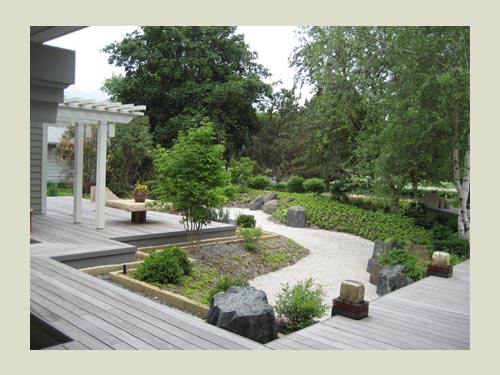Dry Garden… A Rain Water Garden – Minnesota Landscape Company
 March 18, 2008
March 18, 2008

Our local governments love it when we think “Green†and incorporating a Rain Water Garden into a project is doing just that. Traditional Rain Water Gardens can look great if planed and maintained properly. These gardens are typically planted with flowering plants that can withstand a lot of water. Since we specialize in Japanese Gardens we considered another approach to the Rain Water Garden, a Dry Garden. Instead of having a high maintenance perennial garden of water loving plants we used the dry pond of this project to collect the runoff from the roof. All of the downspouts on the garden side of the house drain into the dry pond of the Japanese Garden where the water permeates into to the sandy soil. The amount of weeding and general maintenance within the gravel area is minimal, especially compared to that of a typical Rain Water Garden, which we have also designed, planted and maintain. However, Japanese Gardens also require a commitment to maintenance. So, instead of spending a lot time weeding the perennial plantings in the Rain Water Garden, the time is spent sculpting the trees, shrubs, cutting back groundcovers, etc… and of course weeding.In a commercial Rain Water Garden we would have a large drain pipe drain the water in the garden when the water level reaches a certain elevation, before it can permeate into the soil. This elevation is typically set by the Civil Engineers working on the design team. In this garden we hid the low point of the dry pond edge, which is also our over flow drainage point, under the entry boardwalk. We set this elevation a few inches above the gravel of the dry pond, so that the pond will stay a dry pond. It was also very important that we used clear gravel with no fines for the drainage field.
 Posted in
Posted in  content rss
content rss